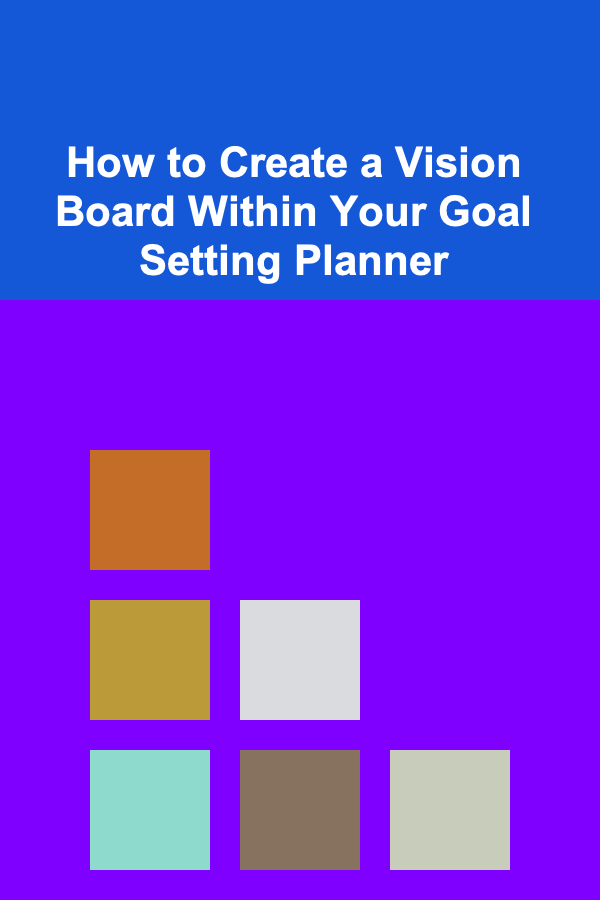
How to Create a Vision Board Within Your Goal Setting Planner
ebook include PDF & Audio bundle (Micro Guide)
$12.99$9.99
Limited Time Offer! Order within the next:

A vision board is more than just a collage of inspiring images and quotes. It serves as a powerful tool to visualize your goals, manifest your dreams, and give direction to your efforts. When combined with a goal-setting planner, a vision board can be a strategic approach to achieving long-term success, serving as a constant reminder of your aspirations.
Creating a vision board within your goal-setting planner provides a structured and focused way to combine the visual with the actionable. It helps translate abstract dreams into tangible steps. In this guide, we'll walk through the process of creating a vision board that complements and enhances your goal-setting efforts.
Understand the Purpose of a Vision Board
Before diving into the practical steps of creating a vision board, it's essential to understand its purpose and how it works.
A vision board is a tool for visualization that allows you to focus on what you want to attract or accomplish in your life. By organizing and visually displaying your goals, you make them more concrete and increase your ability to achieve them. Your vision board can represent anything from career goals, personal growth, relationships, health, to travel and financial milestones.
Why Combine a Vision Board with a Planner?
The beauty of combining a vision board with your goal-setting planner lies in the integration of inspiration and action. A goal-setting planner breaks down your goals into actionable steps, while a vision board serves as a visual anchor, keeping you motivated and focused. Together, they provide a harmonious system that helps you manifest your dreams while keeping track of the journey.
Benefits:
- Clarity: Helps clarify what you truly want to achieve.
- Motivation: Keeps you motivated by giving you a constant reminder of your vision.
- Focus: Allows you to filter distractions and stay aligned with your purpose.
- Manifestation: Reinforces the idea that you can make your dreams a reality through focused action.
Gather Supplies for Your Vision Board
To create a vision board, you need a few materials to bring your vision to life. These can be as basic or as creative as you like, depending on your preferences.
Supplies You'll Need:
- Your Goal Setting Planner: Whether digital or physical, this is where your vision board will live. If you're using a digital planner, you can create a vision board using design tools or apps like Canva, while a physical planner can use cutouts, images, and glue.
- Magazines, Printouts, or Digital Images: Look for images, phrases, or words that resonate with your goals. Magazines and newspapers are great for finding inspiring visuals. Alternatively, you can print images or graphics from the internet or use digital tools.
- Scissors and Glue (for physical planners): If you're creating a physical vision board, scissors and glue are essential for cutting and sticking your visuals onto your planner.
- Pens, Markers, and Stickers: Add decorative elements, notes, or motivational words to personalize your vision board.
- Access to Design Software (for digital planners): For a digital vision board, use tools like Canva or Photoshop to arrange and design your board.
Reflect on Your Goals and Values
Before you start cutting and pasting images onto your vision board, it's important to reflect on your goals. This step is crucial because your vision board should represent your most important aspirations, not just things that look good.
Consider These Areas of Your Life:
- Career and Professional Life: What kind of work do you want to be doing? Do you aspire to get a promotion, change careers, or start your own business?
- Health and Well-being: Are you focused on physical fitness, mental health, or emotional well-being? What specific habits or changes do you want to implement?
- Relationships and Family: How do you want your relationships to evolve? Do you want to attract love, improve family dynamics, or build stronger friendships?
- Personal Growth: Are there skills you want to develop, habits you want to build, or personal challenges you want to overcome?
- Financial Goals: What financial milestones do you want to reach? Whether it's saving, investing, or paying off debt, how do you envision your financial future?
- Lifestyle and Fun: What experiences do you want to have, whether it's traveling, learning new things, or exploring hobbies?
Prioritize Your Goals:
Once you've identified the key areas you want to focus on, prioritize them. You don't need to try to fit every goal onto your vision board. Instead, focus on your top three to five goals that align with your long-term vision. These will be the areas where you will direct most of your energy.
Select Visuals That Represent Your Goals
The most powerful part of a vision board is the visuals. Your chosen images should evoke strong emotions that align with the feelings and desires you want to manifest. For example, if one of your goals is to run a marathon, look for pictures of athletes running, a finish line, or someone achieving a physical feat.
Tips for Selecting Images:
- Choose What Resonates with You: The images should evoke excitement, happiness, and motivation. These can be photos, quotes, or even abstract designs that remind you of the feeling you want to experience.
- Focus on Positive Symbols: The images you select should symbolize abundance, success, peace, or whatever values are central to your goals. Avoid any negative imagery that could deter your motivation.
- Think Beyond the Obvious: For example, if your goal is to become more organized, you might find an image of a tidy desk, a bullet journal, or a minimalist home. Look for visuals that represent the essence of your goals, not just literal representations.
Organize Your Visuals:
- Theme-based Organization: You might choose to organize your vision board around specific themes, such as career, relationships, health, etc.
- Placement: On a physical vision board, place the most important or highest-priority goal at the center. In a digital planner, you can design a clean and organized layout with sections for different categories.
Integrating the Vision Board into Your Planner
Now that you have your goals and images, it's time to integrate the vision board into your goal-setting planner. The key is to ensure that it's not just a decorative feature but a functional part of your planning process.
If You're Using a Physical Planner:
- Choose a Section for Your Vision Board: You can create a dedicated section within your planner or even dedicate a few pages for your vision board.
- Arrange Your Visuals: Cut out your images and quotes and arrange them on the page in a way that makes sense to you. You can add bullet points, personal notes, or goals underneath the images to remind you of the action steps needed to achieve each one.
- Glue Everything Down: Once you're satisfied with the arrangement, glue the images into place. You can also add stickers, washi tape, or other elements to further personalize the board.
- Create a Progress Tracker: Beneath your vision board, set up a section in your planner where you can track your progress towards these goals. For example, a simple checklist for each goal can help you stay on track.
If You're Using a Digital Planner:
- Create a Visual Layout: Use tools like Canva, Google Slides, or Photoshop to create a digital version of your vision board. Arrange the images in a visually pleasing way that represents your goals.
- Add Text and Details: You can add goal descriptions, action steps, and deadlines next to your images or incorporate these into the design itself.
- Incorporate Interactive Elements: Many digital planners allow you to create clickable sections. Use hyperlinks to connect specific goals to other pages where you outline detailed action steps.
- Set Reminders: Digital planners often have reminder functions. Set recurring reminders to review your vision board, adjust goals, or track progress.
Align Your Goal-Setting Process with Your Vision
Once your vision board is set up in your goal-setting planner, the next step is to align your goal-setting process with the visual elements on your board. This is where the actionable part comes in.
Create SMART Goals:
For each of the images and goals on your vision board, create SMART goals (Specific, Measurable, Achievable, Relevant, and Time-bound). This ensures that your vision becomes a reality through concrete steps.
For example:
- Vision: A picture of a healthy, fit person.
- SMART Goal: "I will run 5 kilometers every week for the next 3 months to prepare for my first marathon."
Break Down Goals into Actionable Steps:
Your goal-setting planner should include steps for achieving your goals. For each goal on your vision board, outline smaller, actionable tasks in your planner. These tasks should be specific and achievable, helping you take one step at a time toward realizing your dreams.
Review and Adjust:
Regularly review your vision board and your progress. As you complete milestones, update your planner and vision board. If your goals evolve or change, adjust the images and focus areas accordingly.
Stay Consistent and Committed
Creating a vision board within your goal-setting planner is only the beginning. Consistency and commitment are key to achieving your goals.
Tips for Staying on Track:
- Daily/Weekly Review: Set aside time each day or week to review your vision board and goals. This keeps them top of mind and reinforces your commitment.
- Stay Flexible: Be open to change. If your goals evolve, update your planner and vision board accordingly.
- Celebrate Small Wins: Acknowledge your progress. Celebrate each small step forward, and don't be discouraged by setbacks.
Conclusion
Creating a vision board within your goal-setting planner is a powerful way to visualize your dreams and turn them into actionable plans. By aligning the visual representation of your goals with a structured planning system, you create a dynamic and motivating tool for success. This approach helps you stay focused, inspired, and consistently moving toward your aspirations. With clarity, intention, and determination, you can make your vision a reality.
Reading More From Our Other Websites
- [Home Party Planning 101] How to Plan a Memorable Home Cocktail Party
- [Home Space Saving 101] How to Organize Your Pantry for Easy Access and Space Efficiency
- [Tie-Dyeing Tip 101] Best Tips for Tie‑Dyeing Home Décor: Transforming Curtains and Throw Pillows
- [Organization Tip 101] How to Set Up a Folding and Sorting Station
- [Personal Investment 101] How to Invest in Commodities for Portfolio Diversification
- [Personal Financial Planning 101] How to Create a Comprehensive Personal Budget That Works for You
- [Home Budget Decorating 101] How to Decorate a Home Office for Productivity and Style (Affordably)
- [Organization Tip 101] How to Create a Homework Station for Your Kids
- [Mindful Eating Tip 101] Why You Crave What You Crave: Mindful Strategies for Overcoming Sweet and Salty Temptations
- [Home Maintenance 101] How to Maintain Your Home's Septic System

How to Categorize Recipes by Dietary Restrictions
Read More
How to Find Budget-Friendly Furniture That Looks Luxe
Read More
How to Monetize Your Craft Hobbies on Etsy and Beyond
Read More
How to Stage a Home with a Small Budget and Limited Time
Read More
How To Write a Resume That Gets Noticed
Read More
How to Plan Copywriting for Email Marketing Automation
Read MoreOther Products

How to Categorize Recipes by Dietary Restrictions
Read More
How to Find Budget-Friendly Furniture That Looks Luxe
Read More
How to Monetize Your Craft Hobbies on Etsy and Beyond
Read More
How to Stage a Home with a Small Budget and Limited Time
Read More
How To Write a Resume That Gets Noticed
Read More